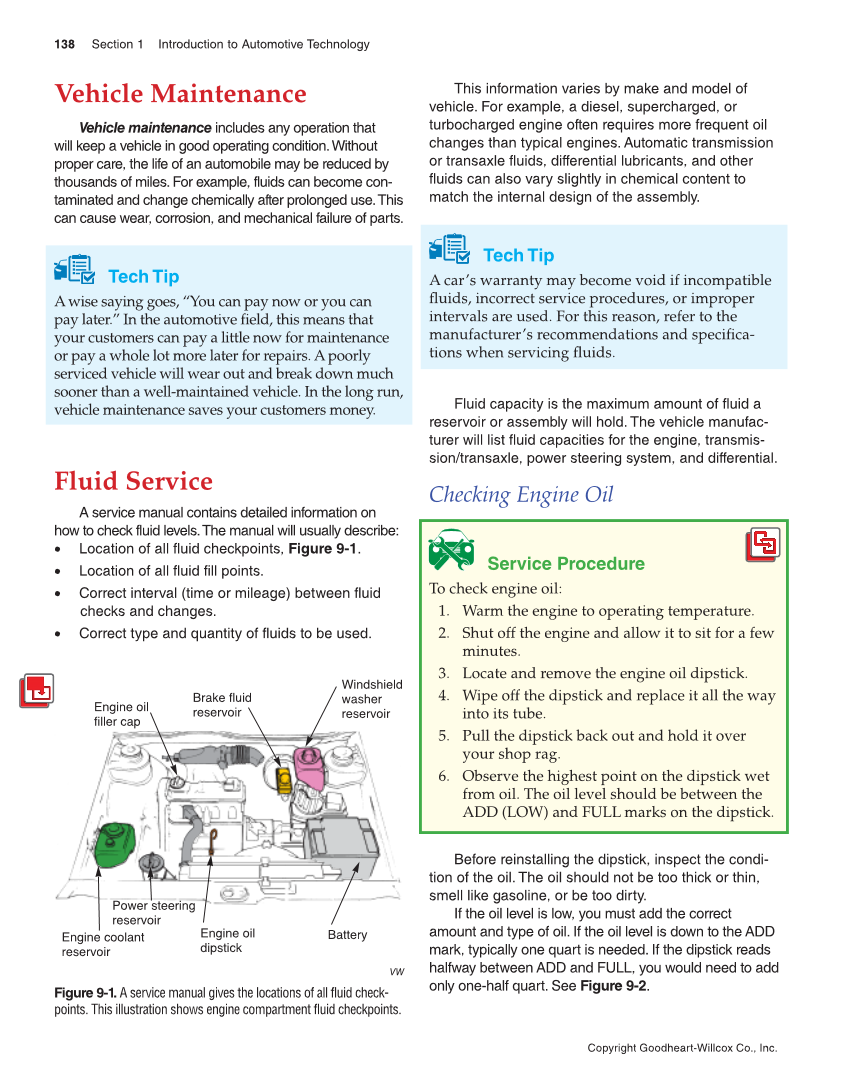138 Section 1 Introduction to Automotive Technology Copyright Goodheart-Willcox Co., Inc. Vehicle Maintenance Vehicle maintenance includes any operation that will keep a vehicle in good operating condition. Without proper care, the life of an automobile may be reduced by thousands of miles. For example, fluids can become con- taminated and change chemically after prolonged use. This can cause wear, corrosion, and mechanical failure of parts. Tech Tip A wise saying goes, “You can pay now or you can pay later.” In the automotive field, this means that your customers can pay a little now for maintenance or pay a whole lot more later for repairs. A poorly serviced vehicle will wear out and break down much sooner than a well-maintained vehicle. In the long run, vehicle maintenance saves your customers money. Fluid Service A service manual contains detailed information on how to check fluid levels. The manual will usually describe: • Location of all fluid checkpoints, Figure 9-1. • Location of all fluid fill points. • Correct interval (time or mileage) between fluid checks and changes. • Correct type and quantity of fluids to be used. This information varies by make and model of vehicle. For example, a diesel, supercharged, or turbocharged engine often requires more frequent oil changes than typical engines. Automatic transmission or transaxle fluids, differential lubricants, and other fluids can also vary slightly in chemical content to match the internal design of the assembly. Tech Tip A car’s warranty may become void if incompatible fluids, incorrect service procedures, or improper intervals are used. For this reason, refer to the manufacturer’s recommendations and specifica- tions when servicing fluids. Fluid capacity is the maximum amount of fluid a reservoir or assembly will hold. The vehicle manufac- turer will list fluid capacities for the engine, transmis- sion/transaxle, power steering system, and differential. Checking Engine Oil Service Procedure To check engine oil: 1. Warm the engine to operating temperature. 2. Shut off the engine and allow it to sit for a few minutes. 3. Locate and remove the engine oil dipstick. 4. Wipe off the dipstick and replace it all the way into its tube. 5. Pull the dipstick back out and hold it over your shop rag. 6. Observe the highest point on the dipstick wet from oil. The oil level should be between the ADD (LOW) and FULL marks on the dipstick. Before reinstalling the dipstick, inspect the condi- tion of the oil. The oil should not be too thick or thin, smell like gasoline, or be too dirty. If the oil level is low, you must add the correct amount and type of oil. If the oil level is down to the ADD mark, typically one quart is needed. If the dipstick reads halfway between ADD and FULL, you would need to add only one-half quart. See Figure 9-2. Engine oil dipstick Engine oil filler cap Brake fluid reservoir Windshield washer reservoir Engine coolant reservoir Power steering reservoir Battery VW Figure 9-1. A service manual gives the locations of all fluid check- points. This illustration shows engine compartment fluid checkpoints.
